Access to electric power allows RVers to enjoy all the comforts of home as we travel. Refrigerators, air conditioners, heaters, coffee makers, microwave ovens, television sets, computers, and the personal devices we use on a daily basis all require energy. And of course, we have batteries to charge. When we’re hooked up to shore power at a campground, the often overlooked piece of gear that carries that electricity into our RV is the ubiquitous RV power cord.
- 1) What is an RV Power Cord?
- 2) Types of RV Power Cords
- 3) Never Plug into a Dryer Outlet or Outlet That Isn’t Rated for RVs
- 4) How to Plug into Service that Doesn’t Match Your RV’s Power Plug
- 5) RV Power Cord Adapters
- 6) Can You Use an Extension Cord for Your RV Power Cord?
- 7) How Do You Know an RV Pedestal Is Safe to Plug Into?
- 8) Free RVing Tips, Tricks, Reviews & Giveaways
What is an RV Power Cord?
All classes of RVs have an RV power cord that runs from your rig to a power source.
For example, if you stay at a campground with partial or full hookups, you’ll have a power source at your campsite. Your RV power cord will plug into the pedestal, and that’s how you’ll power the outlets in your RV during your stay. It will also charge your batteries.
Types of RV Power Cords
RV power cords are available on RVs in 15-amp, 30-amp, and 50-amp versions, usually in lengths of 25 or 50 feet. Let’s talk about each version, and then we’ll address the issue of extension cords.
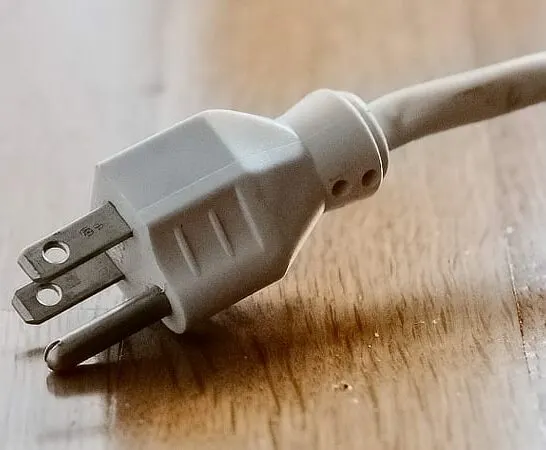
Everyone recognizes this type of plug! This is a 15-amp plug, typical on the smallest RVs.
15-amp RV Power Plug
Everyone knows what a 15-amp RV plug looks like. It’s exactly the same as the 3-prong style you use to plug just about any type of electric appliance into a standard outlet in your house. It has two thin, vertical prongs (one is “hot” and the other “neutral”), and a third, round one, that connects to the ground wire.
Usually, the smallest RVs with the lowest load requirements have a 15-amp RV power cord, like small pop-up campers or very small towables. Typically, if the RV doesn’t have an air conditioner, its power demand is low enough that all it needs is a 15-amp connection.
The total amount of power you can use at any one time in a 15-amp RV at 120V service would be 15A x 120V = 1,800 watts.
30-amp RV Power Plug
A 30-amp plug on an RV power cord also has three prongs: one prong is a 120-volt hot wire, one is a neutral wire, and the third is a ground wire. In addition to being a physically larger than a 15-amp plug, the prongs are arranged differently, with the thin prongs being at an angle, instead of parallel / straight up-and-down.

A typical 30-amp RV power plug, commonly found on mid-size RVs with only one A/C unit.
Usually, mid-size RVs with lower load requirements have a 30-amp RV power cord. One example would be a Class B campervan with a single air conditioner.
To give you an idea of how much electricity a 30-amp feed brings into your RV, a 30-amp, 120-volt service = 3,600 Watts.
50-amp RV Power Plug
A 50-amp power cord (for larger RVs) has four prongs that correspond to TWO 120-volt hot wires, a neutral wire, and a ground wire. Even though it’s called a 50-amp connection, it actually supplies two separate 50-amp, 120-volt feeds.
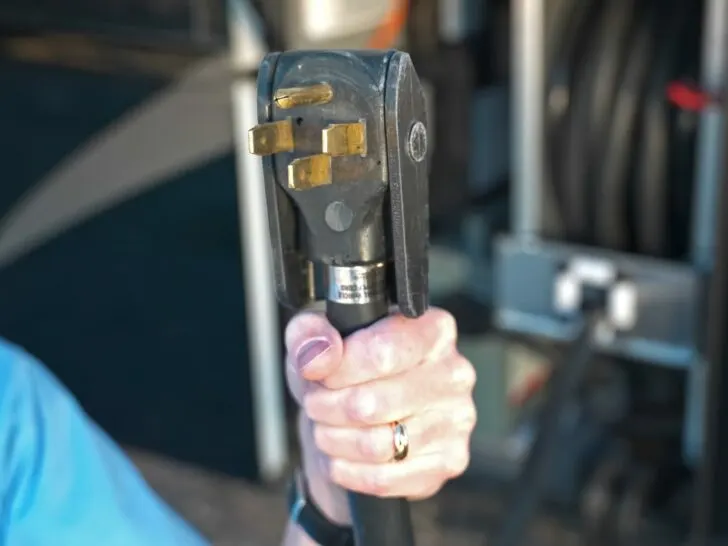
This is the big one… 50 amps… which virtually all large RVs are equipped with.
As a result, a 50-amp feed brings a total of 12,000 watts into your RV with 6,000 watts from each hot wire.
Most 50-amp RVs are wired to use each side of the 120-volt service separately, sending 120-volts to two separate “legs” of service. Usually, half of the RV’s 120-volt circuits are powered by one leg, and the other half are on the other leg.
But it’s still the same 120-Volt system as on all smaller RVs. It’s only on a few very high-end motorhomes (usually bus conversions) that you might expect to see 240-volts available through this same type of plug… most often for supplying high-voltage power to a 240-volt dryer (and ONLY that circuit is provided 240-volts… everything else in the RV will be wired to use 120-volts from one or the other leg of power).
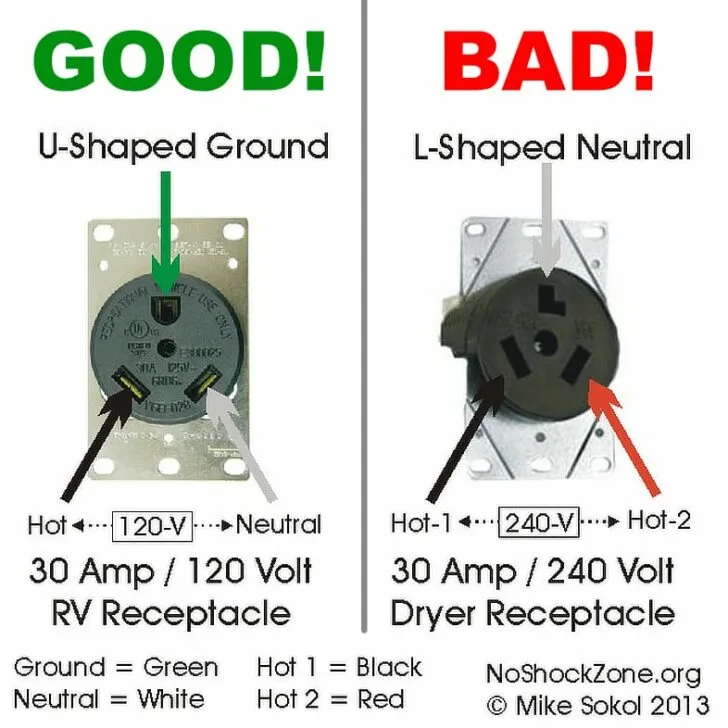
Don’t confuse these outlets! Check out NoShockZone.org for more info.
Never Plug into a Dryer Outlet or Outlet That Isn’t Rated for RVs
Speaking of dryers… Heed this critical warning: NEVER plug an RV into a clothes dryer outlet!
Many people are confused by this because your dryer’s outlet will look very similar to a 30-amp plug, ready to accept the three prongs.
But dryer outlets are wired differently than a 30-amp RV outlet and supply 240-volts as opposed to the 120-volts your RV is expecting.
Connecting to a 30-amp dryer outlet risks seriously damaging your RV’s entire electrical system and possibly even starting a fire.
Don’t do it. Ever!
How to Plug into Service that Doesn’t Match Your RV’s Power Plug
Now, let’s talk about all the cool things you CAN do and how to do them safely, beginning with using RV power cord adapters, better known as “dogbone” adapters.
If you have a 50-amp RV (you can tell by looking at your shore power plug) and the only service available to you is 30-amp service, don’t despair! There are adapters for this purpose. They’re called dogbones because of their shape (thin in the middle and fat on both ends).
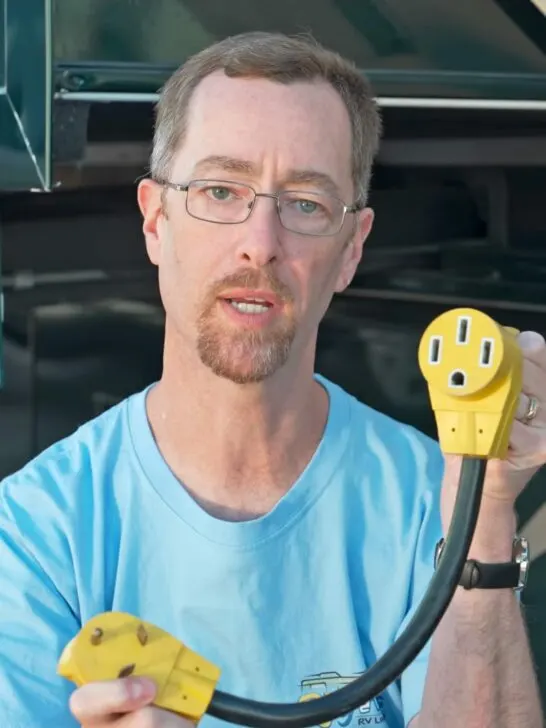
John’s holding a 50-amp female to 30-amp male dogbone, which lets us plug our 50-amp rig into a 30-amp outlet.
Using this example, if you want to plug your 50-amp RV into 30-amp service, you’ll need a 50-amp female to 30-amp male adapter. This will allow you to plug directly into 30-amp shore power and will not cause damage to your RV or the power service.
Another example would be to plug your 30-amp RV (again, if you’re unsure that’s what you have, just look at your power plug) into a 15/20-amp outlet at a campground… or at your home. It’s a common scenario for RV owners, and you can do it safely using a 30-amp female to 15-amp male adapter. Again, you won’t damage your RV or the power service. But…..
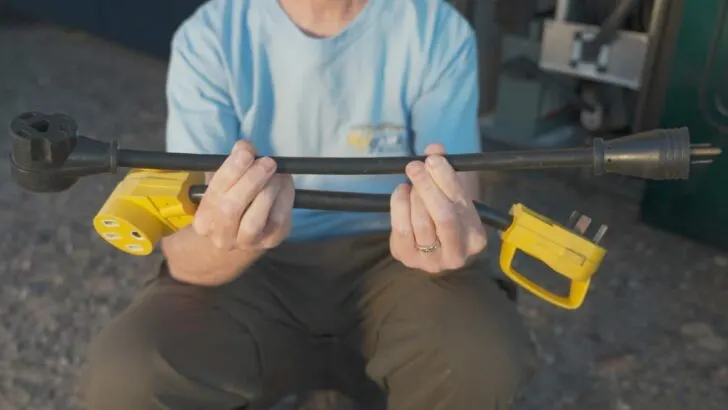
You’ll likely want to carry more than one adapter.
In both of the above scenarios, you need to be aware of the fact that you’re connecting to a lower-power supply than your RV is capable of using. That simply requires being thoughtful about how much power you use at any one time.
A 15/20 amp outlet can run items like a coffee maker, a hairdryer, or a toaster… but not all at once. So don’t make breakfast until you’re done drying your hair!
If you try to run more than the outlet you’re plugged into can handle, you’ll trip the circuit breaker. But it’s never a good idea to RELY on that happening (plus, it’s not all that convenient… you know it’s going to trip while it’s raining out, LOL!).
RV Power Cord Adapters
There are a couple of different RV power cord adapters available to you. It’s essential to get the correct type that corresponds with your RV’s application.
Dogbone Style Adapter Types
A dogbone style adapter has the two adapter plugs separated by a short, heavy-duty cord (making them LOOK like a dog’s bone). These will often have a molded handle on one side to make plugging it into (and removing it from) the power pedestal easier.
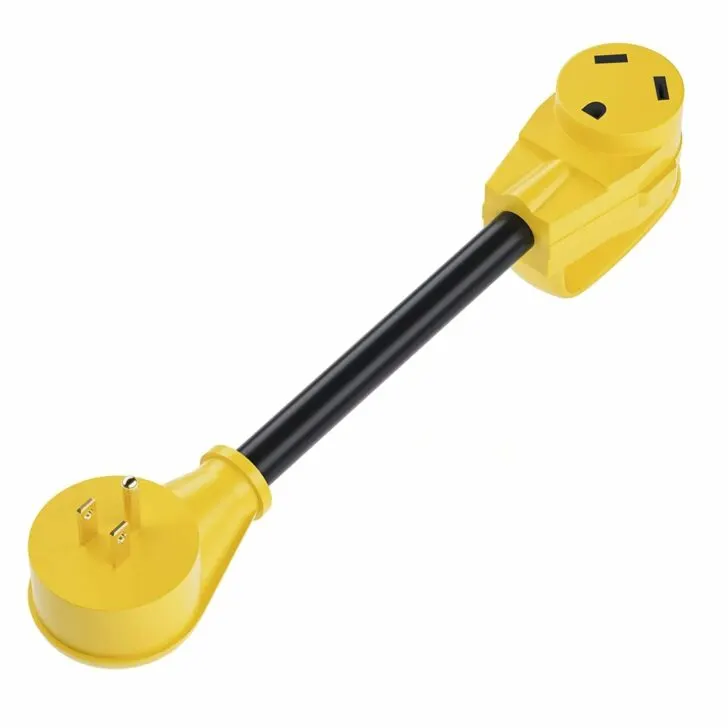
This dogbone allows a 30-amp RV power cord to plug into a typical household 15/20-amp outlet.
Running off a smaller power source than your RV is able to take advantage of isn’t a problem, as long as you keep that limitation in mind, and don’t overload the circuit by trying to use too much power at any given time. Here are links to commonly-used dogbone adapters:
- 50A Female to 30A Male Dogbone (connect a 50A RV to a 30A outlet)
- 50A Female to 15A Male Dogbone (connect a 50A RV to a 15A outlet)
- 30A Female to 15A Male Dogbone (connect a 30A RV to a 15A outlet)
Puck Adapters
Puck adapters work like dogbone adaptors by converting your RV’s plug to a different size/style. They’re a single small unit (like a small hockey puck) that has the necessary female outlet and male prongs to make the conversion, but don’t have the short length of cable to connect the two plugs, like a dogbone style adapter does.
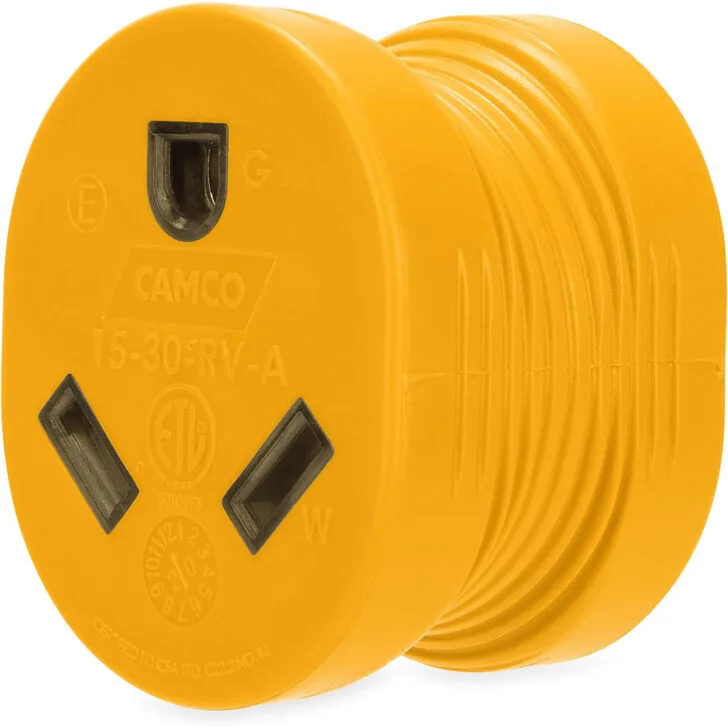
This is referred to as a “puck adapter”, a different style of electrical adapter vs the larger dogbone type.
To use it, you’d connect your RV’s power cord to one side of the puck adapter and plug the other end into the power pedestal (or an electrical outlet at your home).
Puck-style adapters are convenient to use because of their smaller size, but have more limited options than dogbones do, generally being limited to 30-to-15 amp connections.
- 30-amp RV to 15-amp Outlet (connect a 30A RV to a 15A outlet)
Interested in learning more about RV power plug adapters (including whether or not it’s possible to adapt your RV’s power plug UP to a higher-amperage outlet), check out our post RV Plug Adapters: Get the Right Ones to Power Up Your RV!
Can You Use an Extension Cord for Your RV Power Cord?
Yes, you can extend your RV power cord’s length with an extension cord, but you must use one that’s properly rated to carry the amount of current you need to use. Never use a regular household extension cord for this purpose. Bear in mind that you’re dealing with high amperage (current) and will be using it outdoors. Standard, household extension cords aren’t appropriate for either of those issues!
The longer the distance that a cord will need to be run to get to power, and the higher the draw, the larger the cord needs to be. A long, thin cord rated for low power draw can overheat. This is no place to consider cutting corners!
Quality extension cords are readily available at reasonable prices. Most importantly, they include the right-sized wiring and safety features for the amperage you’re dealing with.
- ULTRA HEAVY DUTY EXTENSION CORD - Our 10 AWG extension cord are made heavy duty for outdoor and indoor use. Great for construction site, home use to...
- WEATHERPROOF & FLAME RETARDANT: Our high flexibility vinyl covering is more resistant to bending and won't break when moved, bent, or pulled for an...
How Do You Know an RV Pedestal Is Safe to Plug Into?
How do you know that an RV power pedestal is safe to plug into? The short answer is you don’t. So, RVers use a surge protector whenever they plug into a campground’s power pedestal. This is the only way to protect your RV if there’s a bad power pole or a surge.
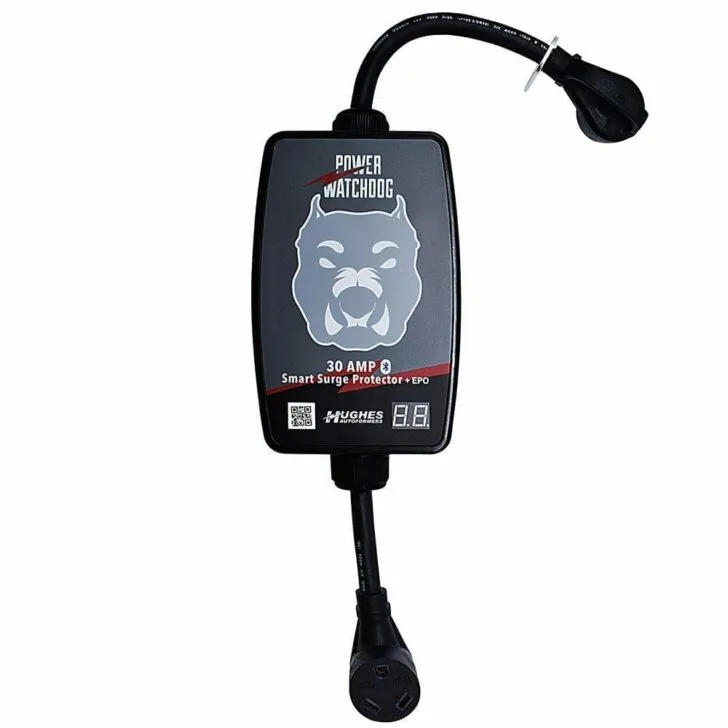
We use a Hughes Power Watchdog to protect our RV’s electrical system.
Let’s have a closer look at why this is important:
An RV surge protector is meant to protect your RV’s electrical system from power surges or poorly-maintained power pedestals in campgrounds. A power pedestal may have faulty wiring, too-low voltage, or frequent power surges (including but not limited to lightning strikes). Any of these things can damage your RV’s electrical system.
In their simplest form, a surge protector plugs directly into the campground’s electrical service pedestal. You then plug your RV’s power cord into the other end of the surge protector. The surge protector acts as an intermediary or buffer for the power flowing between the campground’s pedestal and your RV… and will most often provide diagnostic lights/indicators to tell you if it detects something wrong with the park’s wiring.
Make sure your RV is protected from low voltage, bad RV park wiring AND power surges when connecting to shore power with a Power Watchdog and/or Hughes Autoformer. We never hookup without ours (we...Show More
Make sure your RV is protected from low voltage, bad RV park wiring AND power surges when connecting to shore power with a Power Watchdog and/or Hughes Autoformer. We never hookup without ours (we have both), and know our RV's electrical system and all our electronics are being protected.
Watch our Hughes Autoformer video
Watch our Hughes Power Watchdog video
Save 10% on your entire purchase when ordering from Hughes!
Show LessThere are other options for surge protection and low-voltage protection that can be permanently installed into your RV, eliminating the need to remember to plug them in when connecting at a campground.
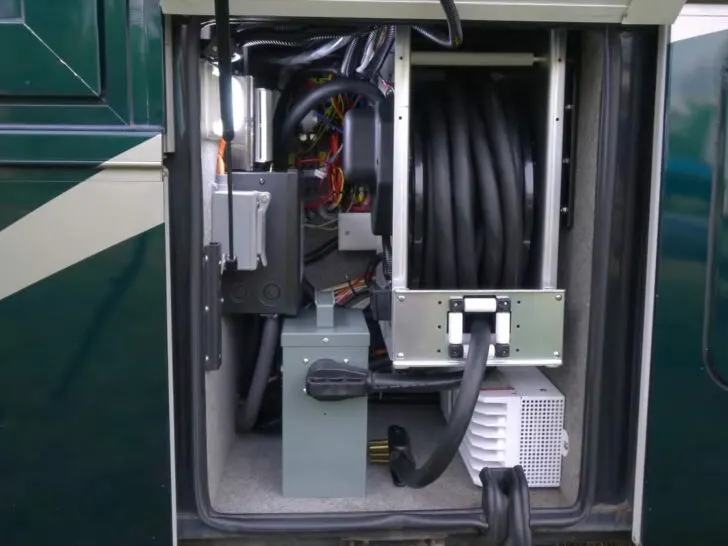
Your RV’s power cord is an essential piece of RVing gear that should be maintained and used safely.
Either way, the surge protector essentially monitors the power coming out of the pedestal before it gets to your RV so that if anything abnormal occurs, it won’t damage your RV’s electronics.
Now that you have a better understanding of your RV power cord and how to use it, you’ll have all you need to bring power into your RV while maintaining optimal safety standards as you enjoy the electricity in your home-on-wheels.
Free RVing Tips, Tricks, Reviews & Giveaways
As 20-year full-timers, we share everything we’ve learned about RVing over the years. Join our online community to receive a wealth of great RVing knowledge delivered daily to your inbox.
Whether you’re a new RVer or a seasoned full-timer, you’ll love the wide range of RVing topics we cover. Don’t miss a single article or any of our famous Giveaways. Subscribe to our newsletter today!

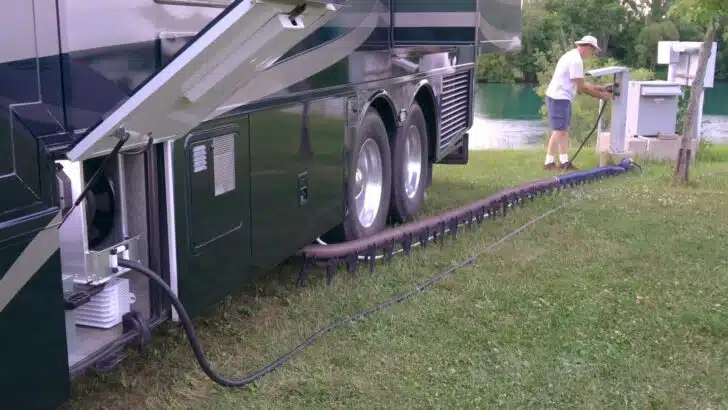

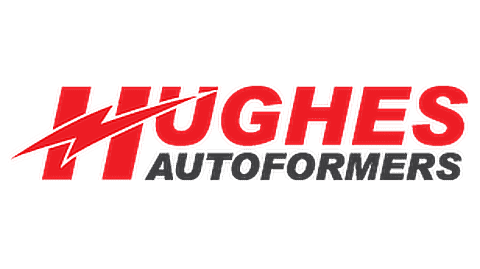
Kimber
Monday 4th of September 2023
Y’all I accidentally ran over the big black power cord coming out of my rv with the mower :/ it’s a 226ft Thor Aerolite with one ac so I assume it was 30minp cord….where does this big cord come from like how do I locate the other end inside my camper so I can replace it? And yes I felt like an idiot for chopping it in half with the mower
TheRVgeeks
Monday 4th of September 2023
Oh no, Kimber. Sorry to hear that! From what you're describing... yes, it sounds like your trailer is most likely a 30-amp unit. You can tell by the number of prongs on the power plug. If it's a large plug with only 3 prongs, that's 30-amp. If it's large and has FOUR prongs, then that's a 50-amp.
Not sure where, exactly, on your Aerolite that the power cord will be attached (so you can remove it and replace the whole power cord), but you should be able to trace it. Usually, the attachment point isn't very far away from where the cord ends at the RV. You may also want to try looking in, or posting in (it's free), the Thor Owner's Forum over on iRV2, as someone there may be able to direct you exactly to where to look.
Hope that helps!
David Robert
Monday 31st of July 2023
Great show! I have a 50 amp RV. If I plug to my dog bone 30 amp and plug into the 30 amp pedestal it trips the breaker, even with my main breaker off in the RV. There is a red lite and a green light on the male end of the 50 Amp? If I put the 15 amp adaptor on with the normal 110 plug and lug in the pedestal doesn't kick? Is my 30 amp dog bone bad or possibly one leg of my 50 amp cable as one light is green and the other red when pugged into the camper. Thanks. Running off the 110 plug and no air-conditioning in this heat wave. Please help!! Thank you
TheRVgeeks
Monday 31st of July 2023
Hi David... sorry to hear about this. Our first instinct is that, yes, you likely have a bad 30-amp dogbone that needs to be replaced. If it was a problem with your 50-amp cable itself, we'd suspect you'd see the trouble all of the time OR you'd have the same problem regardless of whether you used a 15-amp dogbone or 30-amp.
One way to test, before buying a new 30-amp dogbone, would be to plug the RV into a 50-amp pedestal and see if it works. If it does... it's not the 50-amp power cord. If it doesn't... it's the cord.
Tim
Monday 24th of July 2023
I just wanted to say that I watch you guys on the RVers show on cable. I have a question. I have an Alliance Avenue 32RLS and I was told that it has 2 legs of power in the 50amp cord. I just purchased a Honda EU7000is. My question is do I adapt my 50amp cord to the 30amp receptacle that is marker 120/240v and have the switch on the 120/240v setting rather than the 120v setting? I am not an electrician but from what I can see in the Honda manual if I only put in the 120V setting it looks like some of the receptacles in the RV will not work. Can you tell me if I am correct in this? Thank you
TheRVgeeks
Tuesday 25th of July 2023
Hi Tim... thanks for watching The RVers! Hope you enjoy the show!
The answer to your generator question would depend on how the adapter for that 120V/240V plug is wired... and what the outlet on the other end of it is like. Based on what we know about the EU7000is (which is limited to what we've read in the manual online), we'd suggest that you use the 120V, 30A outlet using their adaptor cord... and then use a dogbone to go from the standard RV 30A plug to your RV's 50A cable. With that setup, you could leave the switch in 120V since you won't be using the 240V output.
The only way we'd be comfortable using the 120/240V 30A outlet is if the Honda adapter cord that plugs in there ended in a standard NEMA 14-50R style outlet. And, even then, we'd want to use a multimeter to ensure that there wasn't 240V AC available on either of the hot lines. RVs are only 120V... and 50A RVs are expecting to see two separate legs of 120V AC each.
Lenora Peralta
Monday 1st of May 2023
My power cord has been replaced on my 1986 Fleetwood Taurus. The guy at the rv place thinks it is the wrong end on it, as it is a 15 amp end. How do I know what end came with it, 30 amp or 15 amp?
TheRVgeeks
Monday 1st of May 2023
Oh boy, Lenora. A couple of indicators would be whether or not you have an A/C unit. If yes, it's likely that the original cord was 30-amp. Also, check the main breaker in the circuit breaker box inside the RV. If that's 15-/30-amp, it should tell the tale... although whoever owned the rig before who swapped the cord may have changed that breaker, too. So that's not definitive.
The other thing you could do would be to try posting your question in the Fleetwood Forum over at iRV2.com (https://www.irv2.com/forums/f107/). They're free to join... and it's possible you could connect with another Taurus owner from the same era who might be able to give some insight.
Chris
Thursday 19th of January 2023
My RV is 50 amp and the male end of the cord is gone with the cord being too short to reach pedistal. I don't have any way of purchasing a new cord right now and it is very cold currently. Can I attach a 30 amp male end to my 50 amp cord as a temporary solution so we don't freeze to death in the mean time? If so how does it need to be done?
TheRVgeeks
Thursday 19th of January 2023
Oh wow, Chris. CAN it be done? Sure... we just always caution people about doing potentially risky things with electricity, because of the potential ramifications.
Putting the 30-amp male end on would, effectively, be hard-wiring in a 50A-down-to-30A dogbone adapter. Ground and neutral wires in the RV's 50-amp cord would mate to the matching prongs in the 30-amp plug. Then you'd wire BOTH of the hot/+ lines in the RV's 50-amp cord to the ONE hot/+ prong in the 30-amp plug.
Check out this article from Mike Sokol explaining how a 30-amp dogbone matches up with the wires in a 50-amp RV plug. Might shed some light: https://www.rvtravel.com/hooking-up-50-amp-trailer-to-30-amp-service-at-campground/
Just be careful, use a multimeter to test everything, and double-check yourself before plugging in!